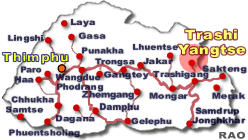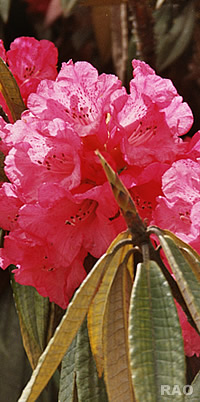 |
Bhutan Culture |
|
 |
Bhutan Information |
|
|
|
|
Trashiyangtse's
dappa industry
|

|
Two
decades ago, Dechenla of Trashiyangste, was another subsistence
farmer living off his small plot of land.
 |
| He often worked as a hired hand
for neighbours and, in the winters, as a seasonal labourer to sustain his
large family of nine. Today, at 53 he is quite content. Life has never
been better. Seven children attend school and his 'business' is flourishing.
Dechenla is an established dappa (traditional wooden bowl) maker
and is one of the few in the dzongkhag to use an electrically operated
motor to craft and mass produce. |
|
 |
| Dechenla at work |
| Traditionally,
Dechenla is not a dappa maker; he apparently picked up the skill from a
close friend and joined the cottage industry in early 70s. Today his seasonal
gross income (eight months in all) average around Nu 150,000 selling about
hundred pieces of dappas and other woodworks. "Earnings and production
has increased," says Dechenla. |
|
The motor produces three times as much as
the manual pedal lathe still used by a majority of the dzongkhag's 25 registered
dappa makers.
For
Jangchu, 47, the art of dappa making is a hereditary profession inherited
from his father. In the trade for over 25 years his annual gross income
is about Nu 300,000. "The market is very good," he says.
| Students
of the zorig chusum institute lacquer their work |
| Traditionally,
Dechenla is not a dappa maker; he apparently picked up the skill from a
close friend and joined the cottage industry in early 70s. Today his seasonal
gross income (eight months in all) average around Nu 150,000 selling about
hundred pieces of dappas and other woodworks. "Earnings and production
has increased," says Dechenla. The motor produces three times as much as
the manual pedal lathe still used by a majority of the dzongkhag's 25 registered
dappa makers. For Jangchu, 47, the art of dappa making is a hereditary
profession inherited from his father. |
|
 |
In the trade for over 25 years his
annual gross income is about Nu 300,000. "The market is very good," he
says.
The
road connection to the dzongkhag has been vital in expanding their market.
While most of the goods are bought on wholesale by the local businessmen
who in turn sell it in Thimphu, often businessmen from Thimphu, Paro drive
up to these producing units and place advance orders before the season
starts.
Apart
from the traditional varieties like the daapa, gophu (small multi purpose
bowl), lhapu (bowls used by monks), ema tshiku (pickle bowl), japhop
(bowl for tea or curry) the dappa makers also produce tiffins, jugs,
plates, cups, spoons, soup bowls, gift pieces, and dinner sets as demanded
by the wholesale buyers. Many of the new products have become popular among
households in urban areas for the unique look it gives to the dining table.
Right now the dappa makers of Trashiyangtse are at their busiest ; the
carving, smooth-ening, polishing and finishing work is on.
top
|
A
Dappa Makers'y Year
|

|
| February
and March |
 |
Collection
of the raw material - the hardwood trees belonging to the Acer species
or Rhododendron - begins in February and March. Local craftsmen cut
the trees into crude shapes, and bring them to the village. The pieces
are roughly carved and soaked in cold water for three months to rid the
(wood) smell and strengthen the wood after which it is dried over wood
fires and left in the sun for about one month. After two weeks, it is boiled
in water as it makes it "easier to straighten the awkward curves and grains".
| June |
 |
By
June the actual carving begins. The rough shapes are spun on the pedal
lathe or the electricity operated motors and smoothened with the leaves
of the sog sog pas shrub (Trema poitoria) which is similar to sandpaper.
Colour is then added with imported dyes from India.
| August
and September |
 |
For
the finishing touch, the most important part of the work, the craftsmen
use tsi, a plant sap available only in August and September from the Rhus
Succedanea tree to polish the wood and fix the colour. The tsi is considered
the soul of the product and cannot be preserved or stored.
| October |
 |
By
October the products are ready for sale. The best and most invaluable items
are those carved from abnormal outgrowths along the trunk that resemble
nodes known as bou and zha in the craft. Both fetch very high prices compared
with those made from other parts of the trunk. On an average, the makers
invest about Nu 50,000 each season, for raw materials, transportation and
labour. They pay a royalty of Nu 480 for a small tree and Nu 1000 for bigger
trees. A dappa can cost anything between Nu 300 to several thousand ngultrums.
The quality is measured in terms of wood, marks, colour, finish, and uniqueness.
Specially crafted work are saved as family heirlooms.
|
The
dappa makers admit that the market has never been better. In fact it is
near impossible to buy a dappa in Trashiyangtse in October because the
products have already been shipped out to be sold in the urban market and
to tourists. But they also admit that the raw materials are getting scarce
although there is no data to measure the extent.
According to Dechenla,
they have been collecting hardwood from Lhuentse, Trongsa, Wangduephodrang and even Dagana for almost for years now. What was nearby exhausted
many years ago. The mass production of wood crafts, driven by market forces,
has also affected the quality of the products says the principal of Trashiyangtse
zorig chusum institute, Lam Kezang.
"Wood items require at least seven
coats of lacquering but local producers use just three coats which soon
wane away, and gave way to damage by insects and the elements," points
out Lam Kezang who teaches the craft of dappa making at the institute.
Prices of the woodcrafts have, however, steeply increased.
A local businessmen
estimates that it has tripled in the last ten years. A dappa which cost
Nu 250 in 1990, now commands about Nu 800. |
 |
And when it reaches Thimphu
showrooms it is twice the price. The dappa makers of Trashiyangtse are
not complaining.
| Information on Bhutan |
 |
|







